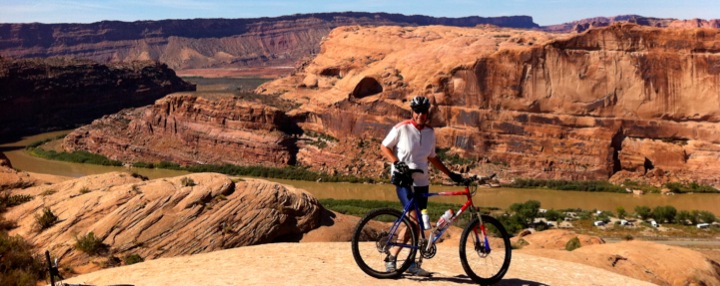The next day I went to Bend’s Pine Nursery Park. A rare Harris sparrow (HASP Zonotrichia querula) had been spotted there the day before; I hoped to find it. I’d never been been to Pine Nursery; I didn’t even know it existed, but it’s a jewel of open space that’s been protected from Bend’s rapidly developing northeast quarter. The park comprises mostly sports fields, and some wide open flat areas designated for future sport fields. A couple large signs detail the ongoing fund raising process for the future sports fields. Other sports fields spread out across several acres, covered in natural turf and artificial turf.
There is also a 20-hole disc golf course spread out among the natural landscape of rolling volcanic bluffs and scrubby juniper forests. The terrain offers stunning views of the Three Sisters Wilderness and a buffer from the busy streets that border the park. I began my search for the HASP by wandering around the meandering trails of the course. Disc courses tend to be enveloped by the landscape they occupy, and it’s easy to wander around as the players have walked here and there to retrieve their discs. Soon I encountered a young man playing alone, wheeling a disc golf cart behind him. His assortment of discs, held in a boxy valise, like pilots wheel through airports carrying their flight tools, were organized neatly like a day-glo record collection. He asked if I was playing. I said no, don’t mind me, play through, I’m just looking for a rare Harris sparrow. He nodded and we talked about how nice the park was. It contained his favorite course, he said, and he tried to play here as often as possible. He winged a disc at a distant cage, then called after the disc as it sailed on. “Get down; get down.” Not satisfied with that shot, he flung another. Apparently, when you play by yourself, you can take as many mulligans as you wish. “I just love this,” he said, motioning to the the sky and landscape and informal course spread out in front of him. “I guess you could say this is my own Harris sparrow.”
I followed the course along the western boundary of the park. There was a lot of foot traffic, kids on bikes, people walking dogs, disc golfers. I was not surprised to see few birds; a couple robins, a scrub jay. But it was a nice day, cold and clear, and I wanted to get the lay of the land and I figured I’d find better habitat eventually. After wandering past the artificial turf fields and a frozen pond (a sign warned: Danger! Thin Ice!) I found better habitat along the park’s eastern boundary, marked with a tall chain link fence. Signage on the fence advises it’s Forest Service land on the other side. That, too, is undeveloped, so this area of the park is mostly landscape of the original high desert biome.
I caught some movement and found dark-eyed junco (DEJU, Junco hyemalis), grazing with golden- crowned sparrows (GCSP Zonotrichia atricapilla) and white-crowned sparrows (WCSP Zonotrichia leucophrys). I’ve never watched sparrows so carefully and I glassed each individual in case the HASP was hanging out with them. I followed the meandering flocks from a dried grass meadow through some brush piles and into an area of young pines. Suddenly, a familiar movement caught my eye. I thought nuthatch, with the dash up the trunk, but I knew almost as quickly this was brown creeper (BRCR Certhia americana). I hadn’t seen one in some time, but the little brown turtle shape is distinctive. I watched the individual for several minutes. He wasn’t shy and I was able to stay fairly close, seeing a lot of detail in his maneuvers as he worked the bark. Up and down the trunk, probing with his long scimitar bill, occasionally dropping a leg behind so he could brace against it to gain leverage. I was amazed how far he could work the bill into voids in the bark, sometimes pulling a small morsel from deep recesses. They could have been small larvae, or maybe even insect eggs of some sort. Again and again he probed, getting deeper in some pockets than others. It reminded my of periodontal charting, a similar, but less pleasant, experience.
I caught a flash of something bigger and quickly located a hairy woodpecker (HAWO Picoides villosus) in the lower boughs of the Ponderosa forest. We get a lot of downy woodpeckers at our home suet feeder, but the HAWO is bigger, and the bill is heavier and proportionally longer. And powerful! This HAWO would BANG, BANG, BANG in a burst of a few blows to the bark, then on the last blow, twist and wiggle his head from side to side, leveraging his bill against the sapwood and prying a chunk of bark away. You could see the lighter bark below as the woodpecker forced chunks of bark away, prospecting for whatever hibernating insects, larvae or eggs he might find.
A few minutes later a saw a chickadee. There was something different about it than the black-capped chickadees we get at our suet feeder at home. I thought mountain chickadee (MOCH Poecile gambeli) and I checked my field guide. The primary difference: the MOCH has a white eyebrow stripe. I got back on the binoculars and sure enough, there was the white eyebrow stripe. More MOCHs appeared and I soon found myself among a small trailing flock as they moved from tree to tree in a loose, trailing formation.
Farther on, I found more YCSP and WCSP, and I glassed each individual trying to turn one of them into HASP. Suddenly, I caught a flash of something in the pod of GCSP and WCSP. Yes! Clear breast, blackish face fading to speckles down the bib! Here was..could it be HASP?! Oops, no. House sparrow (HOSP Passer domesticus) We were moving farther from Zonotrichias.

Again, beautifully written!❤️
Wonderful!